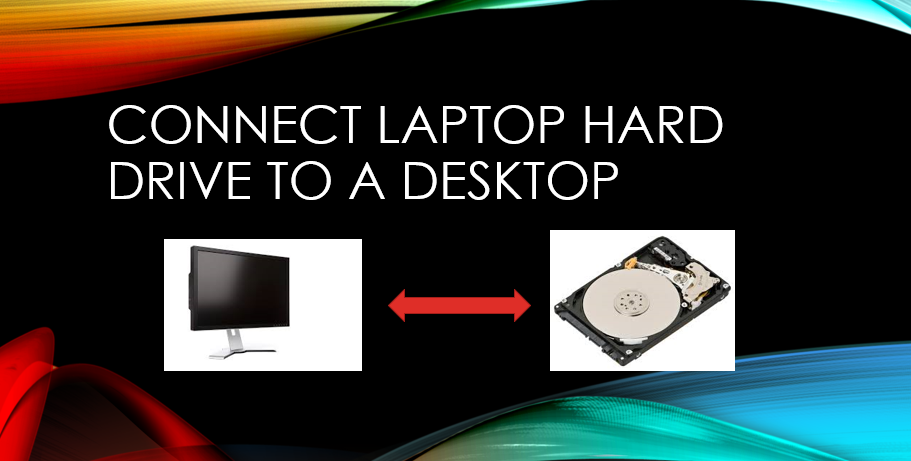In this article, you'll find the steps to safely connect a laptop hard drive to a desktop. You'll learn about the various adapters or connectors which can be used to connect a laptop hard drive to the desktop and you'll also learn about the advantages and disadvantages of the process.
Table of Contents:
Laptop and desktop computers were considered the master brainiest of the modern era. These two things paid platforms to their development as well as industry development. Though they work similarly, the physical components differ by size and other factors to comfort the user at their earnest boundary levels.

The hard drives used in laptops can be categorized into three IDE, SATA, and solid-state drives (SSD and SSHD). Though these drives are generally found in this generation, the main difficulty is with the desktop motherboards. Only if the motherboard supports and provides an option to connect the hard drive then only it’s possible to connect it. There are chances that a laptop may damage severely and need to perform hard disk data recovery.
Yes, you may easily use a laptop hard drive on a desktop.
All you have to do is connect the 2.5′′ laptop hard drive to the computer using the following cables:
SATA Data cables connect one end to the SATA ports on the motherboard and the other end to the hard drive. Because both ends of the SATA Data cable are identical, you don't need to worry about orientation. SATA Data cables are distinguished by their L-shaped key. SATA Data Cables are frequently included with motherboard packages. If you do not have a spare SATA cable, you can easily obtain one.
Obstacles when you connect a laptop hard drive to a desktop:
Motherboards of an earlier time that use PS2 connectors or add-on support to connect other hardware components are not suitable for laptop hard drives. They don’t have the provision to accept laptop hard drives and support a maximum data transfer rate of only 100 Mbps. The motherboard should have IDE and SATA compatibility at a minimum to connect laptop hard drives. It is a complex process to connect SATA and SSD laptop hard drives in motherboards with IDE compatibility alone.
The laptop hard drives can be easily connected to the desktop motherboards using connectors. These connectors and adapters are nothing but serial buses and synchronous devices to connect laptop hard drives to motherboards. The hard drives can be connected in two ways.
It depends on the connectors and adapters used. Suppose the motherboard doesn’t have USB support. You can use IDE to IDE, SATA to IDE, and SSD to IDE type connectors to link. If the board supports USB, then the connection is not a complex issue, and no need to open the CPU cabinet and wiring stuff.
Note: Before you head to try and connect the laptop hard drive to the desktop, make sure you take complete back of your SATA hard drive data using a reliable data recovery tool like Remo Recover.
Figure: SATA cable
Before starting, shut down the PC and remove the power cords from the plug points, as they may damage the ductile components.
Change the jumpers on the hard drive or change the first boot device priority in order to mount the laptop hard drive as a non-bootable storage device.
(Jumper – a minute mechanical component in HDD that indicates the motherboard whether it is primary or secondary)
The speed of the data access and retrieval depends on the desktop motherboard and processor speed because the hard drive is just only a secondary storage device, and the entire control is on the desktop PC. The main drawbacks of using USB over a direct connection with the motherboard are:
Types of connectors and adapters:
Nowadays, they are available to bundle at low cost in PC hardware stores and e-commerce websites. Here the type is listed based on its functionality. They are IDE to IDE, IDE to SATA, IDE to USB, SATA to IDE, SATA to SATA, SATA to USB, SSD to IDE, and SSD to SATA.
Connecting a laptop hard drive to a desktop computer can have several advantages. Here are a few:
It's important to note that when connecting a laptop hard drive to a desktop, you may need additional accessories or adapters depending on the compatibility of the connectors. Additionally, it's always recommended to handle data transfers and drive connections with caution to avoid any data loss from external hard drives.
Yes, a laptop SSD can be used on a desktop and vice versa.
Whether your laptop has an NVMe SSD or a SATA SSD, both can be installed on a desktop if your desktop has the necessary slots.
SSDs are classified into two types:
A 2.5′′ SSD drive is the same size as a 2.5′′ Hard Disk Drive. It can be used on both a laptop and a desktop computer.
SATA SSDs use the SATA interface and are available in 2.5′′ and M.2 form factors.
NVMe SSD, on the other hand, outperforms due to its use of the PCIe interface. NVMe SSDs are only available in M.2 form factors and cannot be found in 2.5′′ form factors.
Caution:
All the connectors supporting IDE hard drives must be minimum IDE 2.5 and above. And if the motherboard supports only IDE, then it has to be IDE 2.5 compatible otherwise, the process will end in assaults.